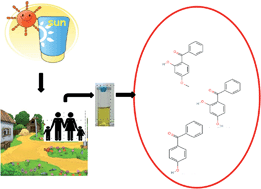Urinary benzophenone-type UV filters in people living in South China: rural versus urban areas
Abstract
Benzophenone (BP)-type UV filters are widely used in sunscreen products to protect human skin from UV radiation. However, only a few studies have been conducted to determine the level of human exposure to BPs in rural areas of China. In this study, we evaluated the exposure levels of people living in three villages and a city in South China to five major BPs (BP-1, BP-2, BP-3, BP-8, and 4-OH-BP). The detection rates of BP-1, BP-3, and 4-OH-BP were 66%, 72%, and 75%, respectively, in rural areas and 85%, 75%, and 80%, correspondingly, in urban areas. BP-2 and BP-8 were rarely detected. The results indicated that people living in South China are extensively exposed to BPs, regardless of sampling sites (rural and urban areas). The observed concentrations of BP-1 (urban vs. rural = 1.04 ng mL−1vs. 0.21 ng mL−1) and BP-3 (0.37 ng mL−1vs. 0.16 ng mL−1) were significantly (one-way ANOVA, p < 0.01) lower in the rural areas than in the urban areas. BP-1 (59%) based on composition profile analysis was the dominant BP derivative in urine samples of urban residents, whereas 4-OH-BP (36%) was the most prevalent BP in rural areas. In the rural areas, significant positive correlations between urinary BP-1 and BP-3 (r = 0.529, p < 0.01) and between urinary BP-1 and 4-OH-BP (r = 0.323, p < 0.05) concentrations were obtained; in the urban areas, we only observed a clear correlation (p < 0.01) between BP-1 and 4-OH-BP. The different composition profiles and associations among urinary BPs indicated that exposure sources of BPs might be different between rural and urban areas. The distribution profiles of BP-1 and its parent compound (i.e., BP-3) in urine decreased with the age of adults (r = −0.410, p < 0.01) in the rural areas.



 Please wait while we load your content...
Please wait while we load your content...